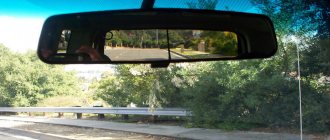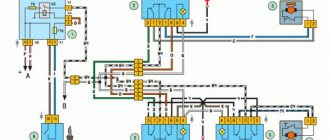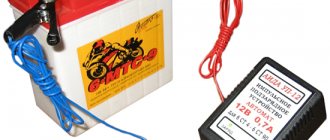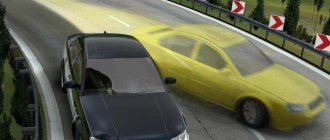Hello All!
I’ll say right away that I’m sorry. I’ve had about 10 years of experience already, I’ve always had front-wheel drive cars, and I got fed up with the fact that they don’t clean the city, and in winter it’s simply impossible to drive around the city, I decided to buy a jeep or SUV, the choice fell on a Toyota RAV4 1997. with 4WD. Well, I rode it in the summer, I was very happy with the fact that you can climb almost everywhere on it, and it’s just right for a family and a summer house. Cool car.And then winter came... Well, I prepared the car for winter (fluids, battery, and suspension) of course, I also changed the tires to winter ones, although not studded ones on Michelin Alpine 4x4 (215/70/R16). In our city, the first snow and ice, as always, like a natural disaster, utility services did not expect snow and did not know it, in the evening there was heavy rain, then it started snowing, in the morning there was already 10-15 cm of snow, and at the same time, already frozen, and there was ice below. I needed to go to the dacha with my mother-in-law in the morning, so I tore the car off the snow, started it, drove off, well, the roads, as always, were not cleared, there were ice blocks at the turns, and on the road there was an ice slide with a ridge. We are not us, we are in a jeep, I am happy that the car drives so well through the snowdrifts, and goes through the snowy mess, well, a great car, super. We left the city, well, as always, out of habit with front-wheel drive, I’m flying at 70 km/h, and I don’t see that on the road outside the city there is a strong wind and ice and crust. Well, okay, I’m flying, and at some point during the detour, I don’t remember what, the car starts to spin (or drifting), out of habit, I have front-wheel drive, I press the gas pedal, I think, somehow I can get out of this drifting, but nothing happens , in front of me, in the left lane, there are cars and a traffic lane, well, I think, as long as I don’t fit in, what the hell, I’ll fly off the road, there are snowdrifts, I’ll brake on them. In these thoughts, I turn the steering wheel in different directions, try to stabilize the movement of the car, and get out of drifting, I move away from the cars, then I see that I am being carried towards the regular groove, the driver, he also sees that I am being carried sideways towards him, We are leaving each other, thank God, we left, while I was being carried towards him, it dawned on me that I needed to slow down with the engine, i.e. You cannot press the gas pedal in this situation. This all happened in just 1-2 seconds. My mother-in-law was sitting next to me and didn’t say anything, I said to myself, screw it, I got some adrenaline, I’ll drive back more carefully, I’ll have enough of this drifting with the first snow. One thing that upset me was that I didn’t notice the number of the regular slot so I could drive up to apologize to him and give him a bottle as a sign of gratitude.
Now the questions: — What kind of driving style should be and is needed on permanent all-wheel drive? — And what should you do to avoid car spinning on a snowy road with ice? I myself understand that I shouldn’t fly, but if I drove carefully and got caught, the car spun. — Explain, I’ve never owned a car with rear-wheel drive, is the driving style in rear-wheel drive almost the same as with permanent all-wheel drive? — What is the best way to get out of an unintentional skid in a car with 4WD? Just take your foot off the gas pedal and brake with the engine? — And I also realized that for all-wheel drive and to drive outside the city, you need studded tires. Spikes, I think, give less chance for the car to spin and be thrown out of the lane.
PS: I understand that I did the wrong thing, I want this to not happen, here are the questions.
Thank you... —- Sincerely, Nikolay Toyota RAV4 (left-hand drive), 1997, 3S-FE, manual transmission
Another cyclone has arrived in Primorye. Forecasters predict heavy precipitation in the form of snow. Most drivers who do not know how to cope with extreme situations behind the wheel commit seemingly ridiculous accidents, causing kilometer-long traffic jams.
The PRIMPRESS correspondent decided to try to rectify the current situation and talked with the head coach, teacher and general director of the Far Eastern Center for Advanced Driving Excellence “Liga-M” Alexander Borisyuk.
Most often in Vladivostok there are cars with front-wheel drive and all-wheel drive. What to do if cars with such a drive get dragged on ice?
– Here it is important to understand what “drags” means, which wheels will slide. If the front wheels slide, this is a drift (loss of control), if the rear wheels, then this is a skid (loss of vehicle stability), if all four wheels slide, this is a side slip or rotation, and each “disease” is treated differently. The most dangerous thing is not to skid, but to lose traction of the front wheels with the road. A skid is only possible when the front wheels hold the road well, that is, this is a slipping of the rear axle of the car. When skidding, you do not lose control, since the front wheels have traction with the road, and they, on any drive, can pull you out of a skid. It is much worse if you have lost the grip of the front wheels, that is, you have lost control; this is underestimated by many. How does loss of control occur? Firstly, this is heavy braking, that is, pressing the brake pedal with excessive force. This is what leads to the locking of the front wheels, that is, to loss of controllability. It's like accelerating, putting your feet on the ice and sliding by inertia. Yes, we will be spun and turned anywhere, but we will go where we accelerated. The same thing happens with a car: if the front axle of the car has lost traction and started to slide, we have an uncontrollable car. Who made the car uncontrollable? The driver who, out of fear, with, say, both feet pressed the brake pedal and is now praying where the hard thing will take him. This is the first reason for demolition to occur.
“It’s much worse if you lose traction on the front wheels.”
The second reason is the excessive speed on the turning arc. All drivers know: the steeper the turn, the lower the preliminary speed for entering it should be. And if the driver realizes that he has entered a turn and the speed is too high, it would be a grave mistake to brake at this moment. Of course, there are techniques for braking on an arc, but these are techniques of the highest driving skill. It is very difficult. Unfortunately, this often happens: overspeed, steering wheel into a turn, brakes to the floor. And then we get skidding, an out of control car, the front wheels sliding and we end up in the oncoming lane or in a ditch.
In winter driving, speed is paramount. A slippery road means the speed should be lower. It is also necessary to abandon jerky steering techniques. Do everything smoothly so as not to “slip” with the front wheels. Also operate the gas and brake pedals smoothly so as not to cause the wheels to slip or lock. Such movements must also be practiced in the summer, so that in winter you will be ready for these road conditions. For some people this is a very difficult task, especially for those who are choleric by temperament. But this is a necessity.
“Unfortunately, this often happens: overspeed, steering wheel into a turn, brakes to the floor.”
Then you need to understand that there are no perfect cars. People think that if they are in a four-wheel drive car, then it is not 4WD, but “four everywhere”. A car with all-wheel drive is truly one of the most off-road vehicles. But it’s not for nothing that the Russian proverb says: “The cooler the jeep, the further you run behind the tractor.” Not everything can be overcome by an all-wheel drive jeep, no matter what it is. And in our city there are obstacles that no car can handle: our hills, for example. By the way, not only the ascent can be insurmountable, but also the descent.
How to get a car out of a skid?
Everyone knows the general advice. If the car has lost control due to a sharp turn by the steering wheel, then you need to reduce the angle of rotation of the front wheels. If a skid occurs on a front-wheel drive car, well, actually, like on any drive, you need to turn the steering wheel in the direction of the skid. This is familiar to everyone from school, but, unfortunately, this rule has never saved anyone, because no one says exactly when to turn the steering wheel, at what speed and at what angle. I’ll put it this way: on front-wheel drive, you need to turn the steering wheel in the direction of the skid and press the gas pedal. No matter how scary it may be, front-wheel drive saves the gas. Moreover, slipping of the front wheels leads to the destruction of any skid. Yes, it may pull a little to the side, but the car will come out of the skid. Of course, it’s scary to press the gas when the car has already lost control, which is why training is needed. But not on public roads, but where there are no people or cars. You need to deliberately throw the car into a skid in order to feel and understand that the gas pedal is your salvation. Only such training should be done under the supervision of an experienced driver.
“In our city there are obstacles that no car can overcome”
On rear-wheel drive, you need to turn the steering wheel in the direction of skidding and reduce the gas. And all-wheel drive is a different story. There is the least time to correct an error - literally one hundredth of a second, and then you need to act proactively. An all-wheel drive car is a very strict car - it does not forgive mistakes. You need to cope with a skid differently than with front or rear wheel drive, by turning the steering wheel all the way in one direction. If we do this, the car will completely lose control. With all-wheel drive, we only have 360 degrees to turn the steering wheel. It’s the same with the gas pedal: you can’t let go of it, you can’t press it harder—at least minimal traction must be applied to all four wheels. And then the most difficult thing is to wait for the machine to cope with the requirements placed on it. Here, too, everything is in general terms. Each car needs to be examined and tested somewhere on the test site. This is the only way to find out what exactly your vehicle is capable of.
We know of more than 60 models of all-wheel drive vehicles, and each of them has its own character! Unfortunately, general recommendations are not enough here. There is no magic secret that you learn and will always get out of a skid, unfortunately. Even “steering towards the skid” is not a panacea. It is best not to fall into these conditions and not to overestimate your own capabilities.
Many people don’t understand: “turn the steering wheel in the direction of skidding” - what does it mean? Where should you turn the steering wheel? For example, we are entering a left turn and the car begins to skid, that is, the rear axle moves to the right, what should we do? Should you turn the steering wheel in the direction where the rear axle of the car goes, or in the direction where the turn goes?
Now I will try to explain to you. Indeed, people do not understand why the steering wheel needs to be turned in the direction of skidding. We are not actually turning the steering wheel, we are trying to maintain controllability on the front wheels. If you do nothing, the front wheel will begin to “slip” around the vertical axis. I will explain in more detail: if the wheels are directed straight or in the direction of the initial movement, it does not matter which direction the skid is performed, then rotation will occur, that is, loss of traction of the front axle and, as a result, loss of controllability. Therefore, our goal is to maintain this controllability; for this we need to maintain the given direction of the wheels. At what speed to turn the steering wheel, I think, is also clear - if the skid is fast, then adjustments by the steering wheel should be fast, if the skid occurs smoothly, the adjustments should also be smooth, and then, depending on the type of drive, add gas or reduce it.
If there is a drift, that is, you turn the steering wheel, but the car does not turn, give up the brake! You need to put the wheels back and try to roll into the turn more slowly and smoothly. There is an exercise called “rolling in.” If we turn sharply, the car will “slip”; if we turn slowly, then no matter how slippery it is, the car will maneuver. There is such ice on the road that you can’t even stand on your feet, but the car has four rubber wheels, and if you don’t interfere with it with the brake, it won’t lose control. He, of course, will not be able to stop, but he will be able to maneuver, go around some obstacle, and there will be a traffic jam. It doesn’t matter how many wheels you have blown off, the front ones or all four, the following principle is important here, unless, of course, someone succeeds in it without training - do not combine steering with braking. On slippery roads, especially on slippery slopes, these things are incompatible. It is necessary to adjust the direction of movement during the brake release phase. Let's say you braked, felt that the front or rear wheels were starting to slide, released the brake, adjusted the car, leveled it, and then you can apply the brakes. We felt the sliding again, released the brake again, corrected ourselves, but under no circumstances should we combine braking with steering, the brake and the steering wheel are incompatible things!
“If you don’t interfere with the car with the brake, it will not lose control”
I don’t know if it’s worth talking about braking; indeed, there are many braking techniques, but they need to be practiced. There are more than 200 ways! And the master chooses exactly the technique that will ensure his safety and the safety of his car under given, specific conditions. A person who does not have such an arsenal of actions, for him there is a panacea of some kind, this is the ABS system - anti-lock braking system. In fact, this is also a “double-edged sword”; it has its pros and cons, but you cannot refuse it. It helps maintain some stability and control of the car during emergency braking. But! With our terrain, you need to keep in mind that ABS does not work at speeds below 10 km/h, and when descending from a hill at a speed below that allowed for the system to operate, the car can slip, and you can also lose stability and control of the car. Therefore, it is better to use that “impulse” technique: braking, adjustment, braking. And so the more often, the better.
Also, if the Ministry of Emergency Situations issues a warning about a snowstorm, you should think ten times: should I drive my own car today? If the situation is such that you have nowhere to go and you have to drive, be prepared that you may stand up somewhere in the middle of the road, be immobilized, and can abandon your car and continue on foot to your home or just to where it’s warm. If you are not ready to abandon your vehicle, then it is important to make sure that you have just a bar of chocolate, a thermos, and a blanket in your car. At the end of the day, is your car fueled enough to keep the engine running overnight without freezing to death? We shouldn’t forget about this, because there were similar tragedies.
What emergency measures are there to safely go down the hill if you were unable to overcome the climb straight away?
It is worth noting here that it doesn’t matter how you are dragged down, in reverse or forward. The principle here is the same - do not block the wheels, let them rotate. If the wheels are spinning, you can change the direction of movement, but if you are scared and still press the brakes, the car will begin to slide, spin and simply become uncontrollable. Therefore, do not interfere with the car with the brake.
“The brake and the steering wheel are incompatible things!”
About the rise. If you understand that you will have time to accelerate, that the dynamics of the acceleration obtained before the climb will be enough for you to overcome the hill, at least with even gas, or even better, covering the gas, then you can try to drive up it.
If you understand that acceleration is not enough for you, that you will have to press the gas on an icy climb, then it is better not to climb there. I'll explain why. Because no matter what drive you have, the car will slip in any case. The slightest slip causes the ice to melt, and a layer of water forms under the wheel. It's like pouring oil under the wheels. And the harder you press the gas, the more water there will be under them, there’s no point in that. Either the inertia gained during acceleration was enough for you to overcome the hill, and cover the gas to reach the top, calculating your strength, or it is better not to climb there.
When driving on a winter road, it is better to use manual control. Nowadays, many cars with automatic transmissions have a tiptronic type manual control function; the names of such systems are different for each manufacturer. We recommend using this particular technique on such snowy, dangerous roads, so that you have in your arsenal not only the brake pedal, but also engine braking. Drive in a lower gear, at higher revs, for example, three thousand on the tachometer. In this case, your gas pedal will be very sensitive, you just “breathe” on it, and the car will move forward, release the gas pedal at least a millimeter, and your car will begin to brake very confidently, although you do not press on the brakes, this is called engine braking . In this case, the wheels do not lock, but the speed decreases.
If your car does not have this feature, simply select a lower gear, such as two, in advance and drive in it. Do not be afraid that the engine is running at higher speeds, it is designed to work in such conditions. Yes, fuel consumption will increase, but now we are talking about safety. If the resulting braking is not enough and you need to reduce the speed even more, then shift the gear down. In this case, the shifting must be sequential; you cannot jump over a gear, for example, from fourth (“D”) immediately to second (“2”), in which case we risk slipping. Engine braking is not an emergency braking, but a gentle one, so you should shift gears sequentially and maintain distance if you decide to use this method of reducing speed. You can combine engine braking with the “pulse” braking we talked about earlier.
On cars with a manual gearbox, it would be good to remember the old, ancient method, without which previously it was impossible to shift at all - this is throttling. This technique will equalize the shafts, and engagement of the clutch will not be so sharp and harsh. Engine braking when shifting with throttle shifting will be smoother.
Careless driving can result in loss of control of the vehicle. Especially in winter on a poorly maintained roadway. A skid in all-wheel drive can lead to a collision, the car overturning and being carried off the road. However, in such a situation, the driver has every chance to regain control and prevent an accident.
This term refers to a situation in which the rear of the car seems to be trying to overtake the front. As a result, the transport turns around its own axis. This is due to different coefficients of adhesion between the bow and stern axles. Moreover, a force is applied to the rear wheels, going at 90° to the direction of movement of the car. The phenomenon is usually caused by driver errors. But not always.
When skidding a front-wheel drive car
In this case, it is usually easier to regain control. So, what to do when skidding on front-wheel drive? You just need to carefully add gas so that the front axle increases rotation and the rear wheels do not “lean” on the nose of the car. At the same time, it is necessary to carefully control the steering wheel, turning it towards the lateral deviation.
Exiting a skid on front-wheel drive does not tolerate sudden braking. Excessive acceleration is no less dangerous. If you press the pedal to the floor, the wheels may spin. This will reduce grip and acceleration with all the ensuing consequences.
Dependence of skills on layout
When improving your piloting technique, you cannot neglect the engine layout.
In front-wheel drive and all-wheel drive cars with a front-mounted internal combustion engine, about 65% of the mass is distributed to the front wheels, which increases the likelihood of understeer. If you incorrectly calculate the acceleration force or the time when exiting a turn, you can seriously harm yourself.
Acceleration of a front-wheel drive car with a front-engine internal combustion engine. The loading of the rear axle increases, reducing the grip of the drive wheel pair (front)
In a rear-wheel drive car with a front-mounted power plant, the directional vector is set by the front wheelset, and the power is transmitted to the rear wheels. 60-50% of the total load is distributed on the front axle, in some cases it is possible to achieve a weight distribution of 50 to 50 - such a balance has a positive effect on the degree of controllability during acceleration. In cars with an engine located behind or in the middle (installed closer to the center of mass), the load on the front wheels is less, which has a positive effect on handling. In turn, the centrifugal force acting on the car when turning, combined with the increased load on the rear wheels, contributes to oversteer.
The image shows a rear-wheel drive car with a front-engine layout. The load on the rear (drive) wheels increases, along with their traction force. But if the driver makes a mistake, understeer may occur.
How to get out of a skid on rear wheel drive
In this case, other actions are taken. The driver will need more skill. The algorithm for how to get out of a skid on rear-wheel drive is as follows. The gas needs to be gradually reduced. This will reduce inertia and centrifugal force. You should not start braking sharply - reduce the speed smoothly by reducing the gas. At the same time, the driver will have to turn the steering wheel in the direction of the skid. You can even act a little ahead.
The described procedure for what to do when skidding on rear-wheel drive is discussed in detail during driving courses. Questions about this are included in the exam papers. When you find yourself in a real situation, you need to remember the theoretical foundations and not get confused due to stress.
Hard to learn, easy to fight
Video about what to do when skidding a rear-wheel drive car:
In order to improve management skills in emergency situations, it is recommended. It is clear that the venue should be chosen away from crowded places and areas of the road where cars drive. In such places, you can artificially create mini-drifts and level them. You can gradually complicate the tasks, and the so-called controlled skid will be eliminated more effectively. “It’s hard to learn, but it’s easy to fight,” - this is what the great commander Suvorov said and taught to live. And in this case, his words go to the root of the problem.
Management Rules
Getting out of a skid is quite difficult. The rules seem to be clear:
Instructions
Remember the situations in which skidding may occur. Firstly, this is a sharp turn, so you shouldn't try to go into it at speed. A number of irregularities on the road can also be a reason for skidding. Ruts can also be dangerous, so try not to fall into them. Skidding can occur when driving downhill or on a descent.
First of all, learn to feel the skid. You can feel the turning of the car with your back. Many inexperienced drivers choose the wrong driving position, trying to move as close to the windshield as possible, while leaving a large distance behind them to the seat. Experienced drivers, on the contrary, like to drive the car in a reclining position, sometimes holding the steering wheel with one hand. Remember - none of this is safe, and an incorrect driving position can lead to dire consequences. Therefore, adjust your driver's seat in such a way that you are comfortable, you are in a strictly sitting position and your back fits snugly against the seat.
As soon as you feel that the car is turning sideways and starting to slide, that is, it is starting to skid, do not under any circumstances try to brake sharply. This can lead to spinning and drifting onto the side of the road or into oncoming traffic. On the contrary, press the gas pedal smoothly, without sudden movements. Do not try to sink it into the floor, otherwise your skid will become rhythmic, that is, from side to side.
When skidding on front-wheel drive, you need to turn the steering wheel in the direction opposite to the skid, while applying gas. As soon as you feel that the car is turning in the opposite direction, release the gas pedal and put the steering wheel straight. After these manipulations, you can stop to take a breath and calm down. When you start moving again, press the gas slowly and remember the rules of behavior on winter roads.
Video on the topic
Related article
Sources:
- front wheel drive skid
In winter, due to weather conditions, the likelihood of an extreme situation on the roads increases many times. What to do to prevent skidding on a winter road?
Instructions
The most insidious type of drive in terms of causing skidding is rear-wheel drive. Therefore, on turns, you should not sharply increase the “gas” and quickly release it; it is better to dose the traction smoothly.
If the car does skid, then you need to turn the steering wheel slightly in the direction of the skid and quickly return it back. If you do not do this in time, then another skid is possible, in the other direction, which will be more difficult to cope with. The third swing is almost impossible to “catch”.
Many modern cars are equipped with anti-lock brakes (ABS). If it is absent on a slippery surface, you need to brake as smoothly as possible, avoiding wheel locking. If it does occur, then you should briefly release the brake pedal and then press it again, thus simulating the operation of the ABS.
Do not sharply lower or increase the gearbox gear - an unexpected skid is possible.
Video on the topic
note
Often, the driver’s panic prevents him from competently resisting a skid. Hence the conclusion: in such a situation, it is very important to maintain composure and under no circumstances let go of the steering wheel.
Sources:
- Portal "Driving school"
It was new for the domestic auto industry to use front-wheel drive in car design. But the success of the eights and nines amazed the designers. These cars were superior to the classics in all respects. This applies to comfort, speed, and reliability.
Instructions
Front-wheel drive cars once gained popularity in our country. When the first eights and nines appeared on the roads, many appreciated them. Of course, they were better than kopecks and sixes, but these improvements are associated not only with the use of front-wheel drive. It is worth considering that the car was completely new for those times. The ignition system, the gas distribution mechanism, the layout of the engine, the design of it and the gearbox, all of this was completely new and had not previously been used in the domestic automotive industry. It is also worth paying attention to the more streamlined body shape, spacious interior, and many other little things that improve driving comfort.
Front-wheel drive cars have both longitudinal and transverse engine layout. The second is most typical for small cars, because the engine and all auxiliary equipment can be placed in a relatively small engine compartment. Of course, the layout is such that there is very little space left under the hood, and sometimes there is none at all.
The engine transmits torque to the clutch basket, which houses the driven disc. The input shaft of the gearbox is installed on the driven disk. Particular attention should be paid to the design of the gearbox. If you compare it with a car gearbox, you can see that the gearbox and drive axle with differential are combined in one unit. This is quite reasonable, but during repairs it causes some difficulties, which relate to removing the box, since it weighs a lot.
The differential is necessary to ensure that the drive wheels rotate at different speeds. If you make a direct transmission of torque, when the wheels rotate equally, it is impossible to turn such a car. For example, when turning right, the right wheel will rotate slower than the left one, because the turning radius of the left wheel is larger and its path will be longer.
The transmission of motion to the wheels is carried out using CV joints, popularly called grenades. These are shafts with ball joints at the ends. One end is installed in the gearbox, and the second in the hub. And the most important thing in front-wheel drive cars is the suspension. As a rule, this is a MacPherson type suspension. It uses a shock absorber strut that is attached to the body through a support bearing. It allows the post to rotate when turning.
The strut has a steering knuckle to which the steering rod is attached. And at the bottom, the shock absorber strut is mounted on the suspension arm using a ball joint. It is also worth paying attention to the steering. Unlike rear-wheel drive cars, it is used here, which has greater reliability. A car with a steering rack is much easier to drive. And you can easily install both hydraulic and electric booster.
Video on the topic
Sources:
- Which drive is better?
A front-wheel drive car has handling characteristics that become evident on slippery surfaces. On a normal, dry surface, when there is no wheel slipping, there are practically no differences in the behavior of a rear-wheel drive and front-wheel drive car.
When driving in a straight line, a front-wheel drive car does not tend to skid, even when driving on very slippery roads. When entering a turn on such a surface, a front-wheel drive vehicle may skid.
Steering wheel turns with braking
The article “Basics of Cornering” described the simplest ways to enter a turn in the following sequence:
- Brake in a straight line
- Release the brake pedal when you reach the optimal speed
- Turn the steering wheel
By combining phases 2 and 3, you can take turns much faster. Try to smoothly lower the brake pedal while simultaneously starting to turn the steering wheel. This skill is called “Braking when turning”
The diagram describes what actions need to be taken with the steering wheel and brakes when entering a turn. By lowering the brake pedal smoothly, you will be able to complete braking before crossing the top of the trajectory
To understand the effectiveness of such a technique, you need to remember the change in axle load. At the moment of braking, the grip on the road surface will decrease and the speed will decrease. The car will not turn even after turning the steering wheel. By releasing the brake, the force required for cornering is released. But at the moment the maneuver begins, you will need only a small part of it. Therefore, you can lower the brake a little bit at a time while turning the steering wheel. The traction force is most effective if done smoothly. The main advantage of this method is that braking can begin later. Moreover, given that the load is shifted to the front axle causing oversteer, corners are taken faster.
This technique is not without its drawbacks. An excessive increase in the load on the front wheels will lead to a significant decrease in load on the rear axle. The result may be a skid, especially in front-wheel drive cars. The flip side of the coin is that an experienced rider will be able to take advantage of this. For cars that understeer, a little rear end drift will allow you to corner faster.
Car skidding
A skid occurs because when the speed decreases, the car is braked by the engine, the rear wheels are unloaded and lose traction, moving sideways. But a front-wheel drive car can be pulled out of almost any skid using traction. Cornering skills must be firmly established in practice, since the driver instinctively begins to slow down when skidding.
If a skid occurs, the driver of a front-wheel drive car must, without reducing speed, turn the steering wheel in the direction of the skid. If the skid has not reached a large angle, then the car can be leveled by simply increasing the speed slightly. There is no need to make corrective movements with the steering wheel.
Front-wheel drive
For a front-wheel drive car, the procedure is as follows:
- turn the steering wheel towards the skid;
- Do not release the gas under any circumstances; By measuring the force, you can even add traction to the wheels. The force that needs to be applied will depend on the degree of development of the skid. In the initial stage of development, even 30% of the pedal stroke will be enough. To overcome a deep skid, the pedal must be pressed to the floor.
The essence of the manipulation is to start performing it with lightning speed, to pull the car out of the skid with the drive axle.
How to enter a controlled drift
A car has long ceased to be considered a luxury item. Today, it is quite common to find families who own two or even three cars at the same time. Modern vehicles, thanks to rapidly developing technological progress, are becoming more powerful and maneuverable every day. In proportion to the growth in engine power, the demands that car owners place on their four-wheeled vehicles are also growing. Every day the number of drivers who strive to master extreme driving techniques, which includes a lot of different techniques, is increasing. Learning extreme driving techniques allows you to control your car in almost any unforeseen situation that may arise even during the shortest and most harmless trip. In this article, we will look at the concept of “controlled drift,” known to many motorists, and tell you how to intentionally enter a controlled drift on cars with various types of drives.
The need for skid control skills
How to get out of a skid - step by step
Every person who even occasionally has to drive a car must have skid control skills. In the absence of such knowledge, when a critical situation arises, an inexperienced driver, through his unprofessional actions, risks provoking a serious accident, which can lead to significant bodily harm to all participants.
A controlled skid can occur in the following situations:
- During an accidental skid, the driver of the vehicle takes the situation into his own hands and transforms the uncontrolled sliding into a controlled skid;
- A car enthusiast deliberately puts his vehicle into a controlled drift in order to get a thrill.
In both cases, minimizing the likelihood of a traffic accident can only be achieved through the cold-blooded application of skills acquired as a result of theoretical and practical study of entering a controlled skid.
It is recommended for drivers who have some driving experience and are well aware of the dimensions of their vehicle to learn this driving technique.
To eliminate the possibility of dangerous situations, such training should be carried out only in wide and deserted areas, specially designed for practicing car driving techniques.
Technique of entering a skid
The basic rule that every car enthusiast needs to take into account, regardless of the type of drive of his vehicle, is as follows: a guarantee of successful entry into a controlled skid is the complete absence of wheel locking during their rotation.
During a skid, you should only work with the gas pedal, and under no circumstances apply the brakes.
Hands on the steering wheel should be in position 3-9, because Only clear movements with a large amplitude contribute to both effective entry into a controlled skid and quick exit from it.
The influence of the road surface on the behavior of the car
The meaning of the nature of the coating
Before performing training runs to enter a controlled skid, you need to assess the condition of the road surface and the value of its coefficient of adhesion to the wheels of the car. Asphalt pavement has a high coefficient of adhesion, therefore it significantly reduces the speed of the vehicle while sliding. Road surfaces based on soil, gravel or other bulk materials have a reduced coefficient of adhesion, and therefore contribute to longer skidding. However, maintaining the vehicle's directional stability when performing these maneuvers in such conditions becomes much more difficult.
Entering a controlled skid in a rear-wheel drive car
On the classics
First of all, a rear-wheel drive car needs to be accelerated well, and then sharply entered into a turn, turning the steering wheel in its direction. This is necessary to transfer additional load to the front wheels. Next, without ceasing to press the gas pedal, you should depress the clutch pedal and release it. This action will cause the vehicle to start sliding sideways on the road surface. Then, to build the correct sliding trajectory, the steering wheel is quickly turned in the opposite direction from the turn. In this case, it is necessary to press the gas pedal with such force that the rear part of the vehicle body does not wobble throughout the entire maneuver, right up to the exit from the skid.
Entering a controlled skid in a front-wheel drive vehicle
Front wheel drive car
As in the previous case, the car must be driven into a turn at high speed, trying to get the rear part of its body to slide. After this, you need to sharply squeeze the clutch, at the same time remove your foot from the gas pedal and pull the parking brake. As a result of these actions, the car will begin to slide sideways, to maintain which you will need to turn the steering wheel in the direction of the skid, turn off the parking brake and depress the accelerator pedal as much as possible. After slowing down the lateral sliding speed, the steering wheel must be released from your hands for a short time, allowing it to return to its original position, after which you must immediately take the steering wheel in your hands and pull the car out of the skid as smoothly as possible.
Passing a controlled drift on a four-wheel drive vehicle
In all-wheel drive it is difficult to enter a controlled skid
It is quite difficult to carefully enter a controlled skid in a vehicle equipped with all-wheel drive. This can be explained by two factors:
- Such cars react very sensitively to pressing the gas pedal;
- All-wheel drive vehicles do not turn well enough in the event of a skid due to the fact that both of their sliding axles are driven.
That is why, while performing a controlled drift, you cannot press the gas pedal as hard as possible, because this will most likely lead to the vehicle turning around its axis. A similar result will be obtained when the driver completely releases the gas pedal.
A correctly performed maneuver will look like this:
- The car takes a turn at high speed, after which the steering column turns in the direction of the skid.
- The driver presses the accelerator pedal in measured doses, maintaining the vehicle in a controlled drift for the required amount of time.
- Completion of the maneuver is carried out due to a clear balance between the steering wheel turns and the degree of pressure on the accelerator pedal.
If you do not have extensive driving experience behind you, then it is best to avoid entering a controlled skid in an all-wheel drive vehicle due to the increased complexity and high danger of performing the maneuver.
It’s hard to argue with the fact that a controlled skid is quite a spectacular sight. However, we should not forget that in addition to entertainment, this type of driving contains many dangers both for the driver of the car and for other people who, by chance, may find themselves near the place where this complex maneuver is performed.
It is strongly recommended to refrain from entering a controlled skid in crowded areas of pedestrians or in a dense flow of other vehicles.
In addition, fans of extreme driving should be prepared for significant financial costs, which will be required not only to purchase new tires, but also to repair the gearbox, clutch and constant velocity joints.
Video
Here is a technique for controlled skidding in an extreme situation:
Enjoy this video showing a truly controlled drift:
auto-wiki.ru
Demolition
Now you know how to stop a skid, but what to do when the wheels are turned out and the car continues to “slide” straight?
You will have to get rid of one more destructive instinct. Most drivers, not feeling the response from the car when turning the steering wheel, begin to twist the steering wheel to an even greater angle. You need to do the diametrically opposite - slightly reduce the steering angle. It is strictly forbidden to press the gas at this moment.
If the gas pedal was pressed at the moment the demolition began, you need to literally drop it. This way you will load the rotary axis a little. You can also press the brake pedal lightly. If the car does not have an ABS system, its operation can be simulated by intermittently pressing the pedal. It is important to prevent the wheels of the drive axle from locking.
As soon as the car starts to turn, you can turn the steering wheel a little again. In this way, you can feel the grip of the wheels with the road surface, overcome drift and prevent the car from skidding.
Practical lessons
Even a perfect understanding of the theory will not help you act adequately in an emergency situation. The main key is practice. You need to learn to feel the car, feel the force of inertia in order to adequately work with the pedals and steering wheel.
It is best to start this practice in winter, since a dry coating will greatly wear out the components and assemblies of your car. To practice, you need to find a deserted section of the road where you could, without unnecessary fear, try to provoke a skid, drift, or slip of all four wheels. Of course, you can also hone your emergency driving techniques on.
With the arrival of winter, driving becomes much more dangerous - it gets dark earlier, wind and snow impair visibility, and ice makes roads treacherous and slippery. A huge number of road accidents occur annually precisely because of the influence of these negative factors. In these conditions, it is extremely important to have safe driving skills. One of these useful skills is the ability to get out of a skid. It is precisely what a controlled drift is that we will talk about today.
Be sure to check out the article about. They will also help you prepare for problems in advance.
The feeling of losing control of the car sometimes leads to panic. As a result, many drivers make poor decisions. As a rule, this problem is faced by beginners who have not thought in advance about what they will do if the car skids. Particular attention should be paid to studying this material by those motorists who studied at a driving school in the summer, when there was no ice on the roads.
Below we have listed the 5 most common types of skids. You will learn what to do when skidding on front-wheel drive and rear-wheel drive. First of all, you need to remain calm and refrain from making sudden movements. Using tips on how to get out of a skid, you can safely operate your car in winter.
Slipping occurs when the driver tries to accelerate too quickly. The wheels begin to rotate at a faster speed than the car. The consequences of this may vary depending on what kind of drive the machine has. Combating slippage is simple: release the gas pedal to restore traction between the tires and the road surface. Then press the pedal again, but do it a little slower and more carefully than the previous time. Essentially, slippage will help determine how well you control the car.
Wheelspin should generally be avoided in corners, but in some cases it can work to your advantage when driving straight ahead. On a flat road covered with ice, there is no real benefit from wheel slipping. But there are other situations. For example, you may find yourself on a climb when there is good asphalt under your wheels, covered with several centimeters of unpacked snow. Tire slipping can help achieve good traction on the road surface. As a result, you won’t have to stop on the climb or slide down. This will also help in mud or other types of slippery surfaces that have a hard base underneath.
Some cars have traction control that can prevent the wheels from spinning in this way. It can either reduce engine speed, apply the brakes, or use both methods. In such cases, it can be very difficult to ride on slippery slides. Sometimes the solution may be to simply turn off the system.
Wheel locking occurs if the driver starts to brake too sharply. The wheels stop rotating, but the car continues to move. Luckily, the solution is also quite simple: release the brakes to allow the tires to start spinning again. Most likely, you will have to completely remove your foot from the brake pedal, and then try again, pressing the pedal more slowly and softly.
Braking on a slippery road is much more difficult than it seems. It is necessary to practice well, and it is recommended to do this outside of busy roads. We advise you to learn how to brake correctly in winter while driving straight on a suitable road without other cars. You need to learn to feel the moment of blocking in order to avoid troubles.
Locking your wheels can sometimes be useful. On loose surfaces, locked wheels will help you achieve better traction faster. On roads with snow, gravel or sand, locking your tires completely will help stop your car much faster.
An anti-lock braking system (ABS) will prevent your vehicle's wheels from locking. It alternately applies the brakes on the wheels, while they continue to rotate. Due to this, the car will not be able to stop very quickly. Don't forget about this, keeping the appropriate distance and leaving the necessary margin for maneuvers.











